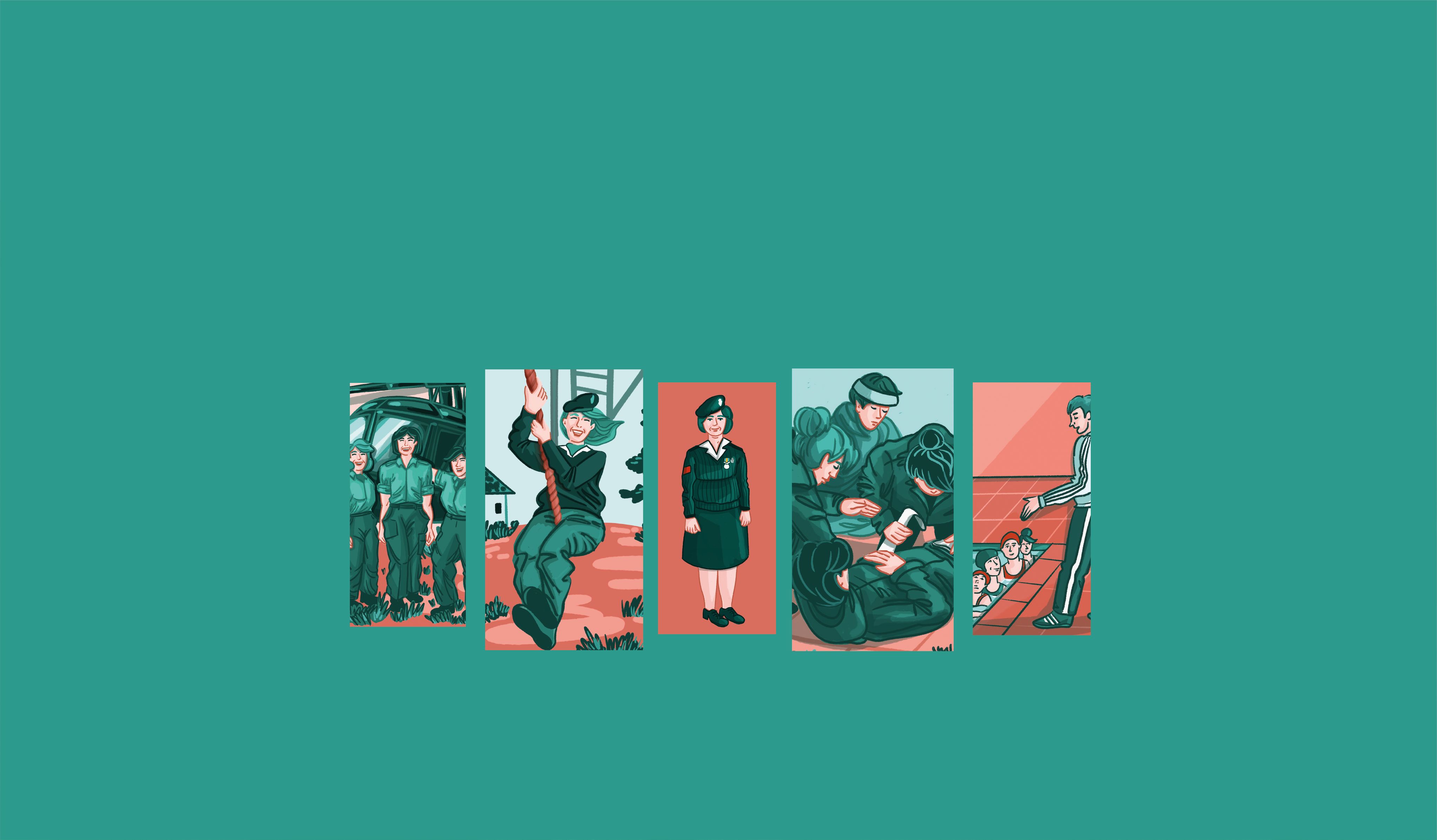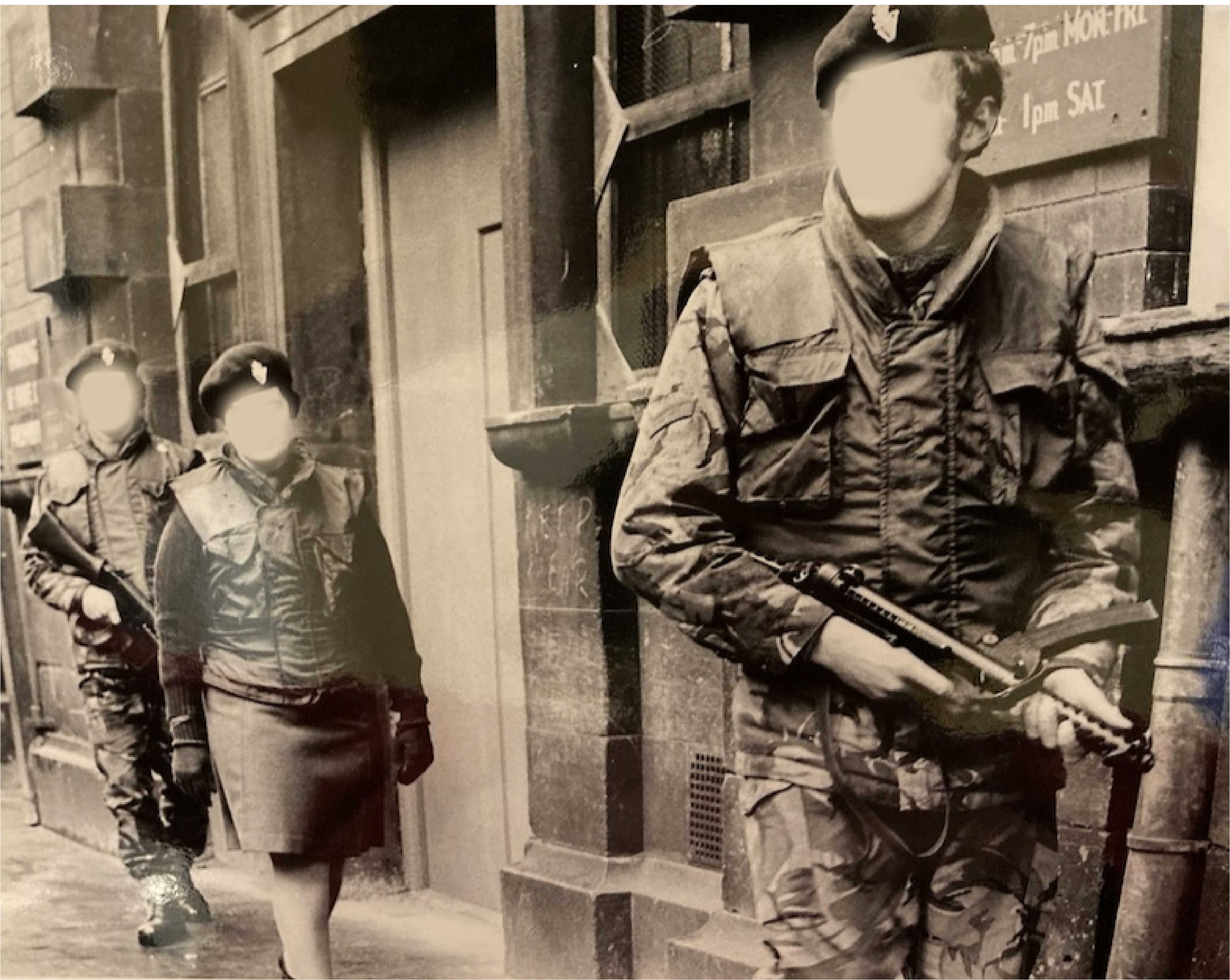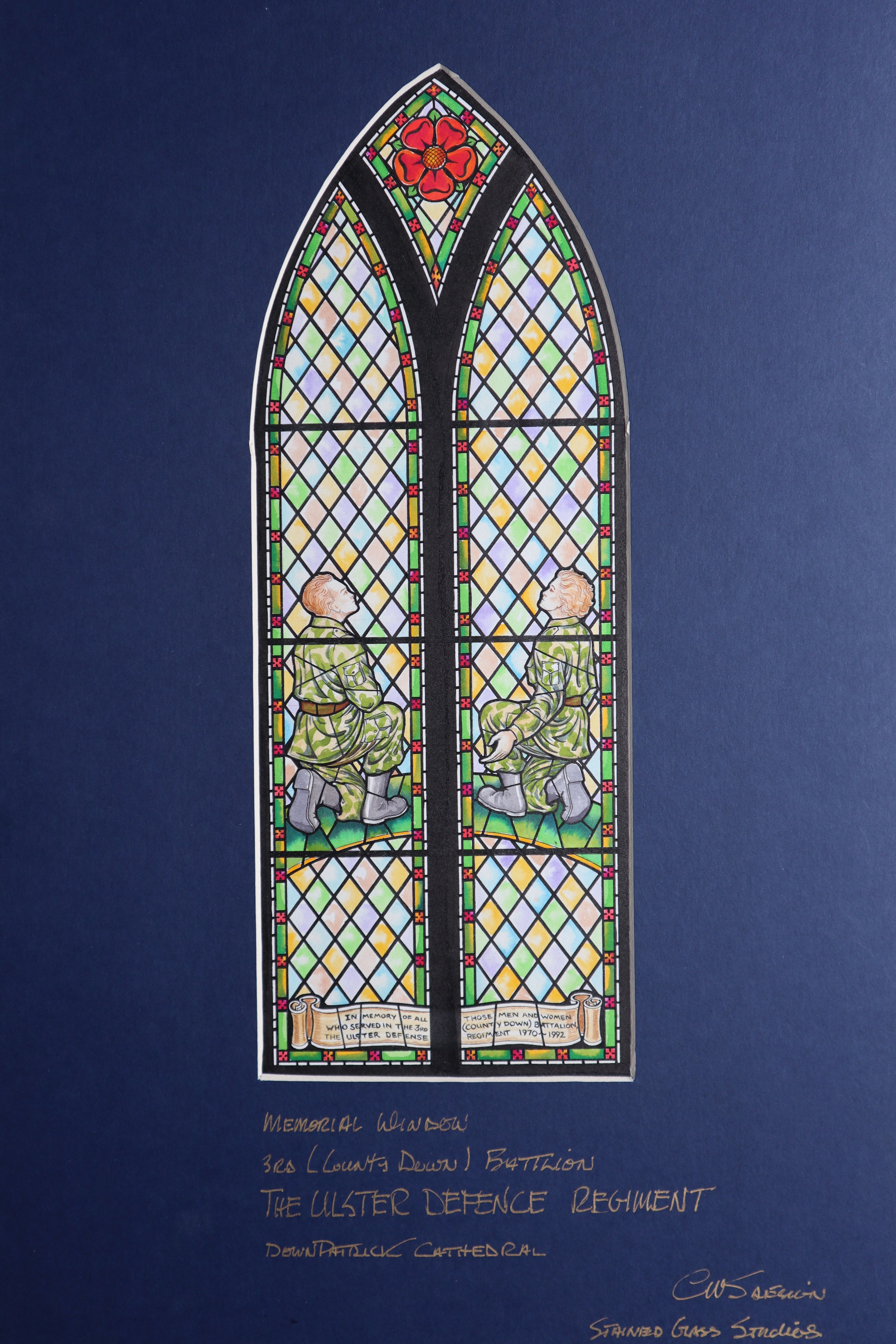"PETTICOAT PATROLS"
What it means to be a Greenfinch.
Dr Hannah West (Project Lead, Cardiff University) | Hannah Richards (Co-Investigator, Cardiff University) | Dr Laura Patrick (Regimental Heritage Officer for The Royal Irish Regiment). Funded by the Arts and Humanities Research Council, and in collaboration with The Royal Irish Regiment and Nifty Fox Creative.

Who were the Greenfinches?
"On 16th August 1973, The Ulster Defence Regiment (UDR) regulations were amended to allow females to be recruited into the regiment.
On September 25, 1973, the first females were enlisted into the UDR." Reference
Hear what it meant to be a Greenfinch in their own words through this audio poem.
Audio transcript Photo reference
Why were they called the 'Greenfinches'?
"The green berets worn by male soldiers in the UDR gave rise to their radio title of ‘Greentops’.
It was a natural progression for women who enlisted into the UDR to be known as ‘Greenfinches.’" Reference
Photo reference
What made the Greenfinches different?
"Greenfinches - as part of the UDR - were unique in that 57% of the soldiers were part time.
So after a normal day’s work as civilians, they would report to their UDR bases for eight hour duties on average two to three nights a week and one weekend per month." Reference
All the UDR soldiers - men and women - lived in their own homes.
On top of the long hours the put in, particularly the part timers, they lived in the knowledge that their lives, and the lives of their family members, were at risk simply because they served with the UDR.
Photo reference
Why were women recruited?
"Women were increasingly seen as a threat."
Statistics Reference


"There is an operational requirement for women searchers with all UDR roadblocks and VCPs if the IRA tactic of using women to carry arms and explosives is to be countered."
Quote Reference
Greenfinch Recruitment
What was it like joining the regiment? Illustration references
"We recommend that a corps of 230 women should be recruited for service as female searchers, clerks, radio and telephone operators at battalion and company headquarters"
"Before a married woman domiciled with her husband is enlisted, her husband is to sign a certificate to the effect that he understands that his wife has applied to join the UDR and that he has no objection."
"There have been many who have denounced the decision to include 'petticoat' patrol members, but whether they like it or not, there is indeed an important role for women to play within the UDR and there is no doubt that women will rally to the call, knowing that they will be carrying our work which is of benefit to the Province in these dark days."
"We propose that the UDR women should be subject to the same conditions as the men, modified as appropriate along the same lines as WRAC service. The conditions include: […] Pay for the women to be 87% of men’s rates as in the regular army."
"The story of the UDR centres on the individual courage and dedication to duty of its members. It requires a very special brand of courage to be a part-time member of the Regiment, particularly in remote border areas."
What was training like?
"Two factors ensure a happy camp: fine weather and good food. The weather was good (except for one misty day) and in spite of the poor food it was a happy camp."
Illustration Reference
"The Camp promises lots of hard but interesting training, an all night exercise with the base camp in a beautiful woodland glade and the possible choice of a “day off” trip to London or France"
Photo reference
"Carol is 26 and works in the health service. In the UDR she is a Lance/Corporal with three and a half years’ service: “The training is relevant. I’ve been in situations in Belfast where my training has paid off. Its also a time to unwind. There’s no tension here. At home I get the odd headache and can be too sharp with people at times because of the pressure. Camp does me a great deal of good"
Photo Reference
"But we were also on the frontline. Basically, from when you stepped out your door, you were conscious then that wherever you go you could run into an incident.[…]. Obviously we had certain areas where the frontline was on people’s doorsteps. […]. You were always conscious that trouble can come to your door."
Photo Reference
"In the city centre, part of it was sealed off with what we called the city segment gates which were opened, unlocked, day and night. And the Greenfinches and even the WRAC initially were on the gates doing searching of females coming through the segment gates. So ,they were searched for incendiary devices, explosive devices, bits of explosive devices that could make up a bomb, once they were inside the segment gates. You know, a lot of the stores got incendiary devices and that left in the coat pockets and sofas which went off after the shops were closed. So the girls, the WRAC and the Greenfinches would have been searching the females and that was the main role on the segment gates."
Photo reference
"In May 1981 she was travelling in the front vehicle of a two vehicle patrol when the second vehicle was ambushed and the driver killed. Having initially administered first aid to the casualty, she then took over control of the radio in order to direct relieving troops to the scene of the incident. At the same time, she also coped with the control of civilian traffic through the immediate area. Throughout the incident she showed initiative, calmness and professionalism with a total disregard for her own personal safety."
Photo Reference
What was the uniform like?
Audio transcript
How has the uniform changed over time?
"At first they wore these, way in the early days, and then they changed the material to wool because it was colder over here. […] At first the poor Greenfinches had to go out on duty with that, there was no trousers. I joined 81 and it was about 83 that Brigadier Baxter who formed the Greenfinches, he, we were at a General Meeting one night and we were giving off about why could we not wear trousers. So they gave us trousers, plain trousers, not the patterned trousers to wear. So the only time we would have worn skirts was on ops room duties, working in the mess, working admin jobs, or you were on parade. But they then you would have had your suit. These [the skirts] were really all done away with in 83, 84 whenever the UDR started to amalgamate."
"I was on patrol that night, so they says right […] you’re going to be the guinea pig, put the puttees on cos you’re going back out on patrol. And one of the Corporals put the puttees on and I had my break and then I was going out on patrol. I remember I was sitting right behind the patrol commander, cos they had the radio and I was starting to feel really, really queasy, […] ‘You’re going to have to stop the Landrover I’m going to be sick’ […] And he turned to me and said, ‘You’re all red’. And I said, ‘I don’t know what it is’. And one of the boys looked down and said, ‘Look how tight her puttees are!’. […] Then then they taught us to cut them in half, just put them round your ankles a couple of times."
"They always said if you didn’t have your knickers on you weren’t insured! […] One night we were having a training night with the men, with the whole company, and there was a couple of new recruits, and they had been winding them up, that was the time we were getting some female recruits in, so they were wanting us to dress up in our proper dress, you know. […] “So we’re having a break now and afterwards we’ll have a wee chat about the Greenfinches”, you know. So […] my mate and I, […] so we put them on you know and they come in again and you know and they were saying to the boys, “Wear your correct uniform or if you have an accident you’re not insured.” And the fellas turned round and said, “What about the women? […] “They have certain pants that they have to wear. And they were going, “What?”. And […] got a picture of them and said, “The girls have to wear these.” […] And […] and I just walked up to the to the front of the stage and said ‘there’ [showing off their knickers]!
How Greenfinches looked in the field was captured in this statue below.
Download the Qlone app above on your phone to see this statue in your living room! Then open the 3D scan file below on your app.
What was it like on patrol?
"I remember we were, one of our platoons had been sent to the border and we were going to pick them up in green vehicles, […] and there hadn’t been a green vehicle move in probably over 10 years. So we had to walk that whole route and check every culvert and I remember walking along Narrow Water, where the paras were…16 paras were killed, to check the culvert, and I’m with a male colleague. He’s armed with a machine gun and I’m unarmed, and the borders…that building. [Male pseudonym here] was a lovely guy, but a wee bit slow and I remember thinking, “One man, and I’m taking that off him.” And I would have."
Photo reference

"I am getting ready to go on duty when my 14-year old son asks, "Do you HAVE to go to work again tonight Mummy?"
It happens to all mums in the WUDR - it's happened to you. He was only four when I joined and he's asked that question hundreds of times in the past ten years.
It makes you think, 'Has it all been worthwhile?' - so I ask him.
He thinks hard for a few minutes (fourteen year old seriousness). 'Of course it has all been worth it; we both know that is the answer'.
He is proud of me. He wishes he could tell his mates about the 'job' his Mum does but he's sensible and knows he can't.
Yes I am proud - proud of my Regiment, proud of myself. We have come a long way in ten years. We are a respected and much valued part of the Ulster Defence Regiment.
My son would not change things - he knows it's the work we do that keeps life as normal as it is for him and his mates in this strife torn community.
He is only one son. There are hundreds of him in Ulster who have sacrificed countless quiet nights at home with Mum. Has it been worth it?
You ask him. I bet I know what he'll say."
A.S
Quote Reference
"My son would not change things - he knows it's the work we do that keeps life as normal as it is for him and his mates in this strife torn community."

But were Greenfinches really seen the same as the men?
"The integral role of the Greenfinches is contrasted with how they were represented in internal documents. Like this cartoon from the Greenfinch Ten Year Anniversary Paper, that makes light of women needing to go to the bathroom in the field."
Cartoon Reference

"Have you ever noticed, Filling, that women are not built like us?"
How did attitudes change over time?
"I give in - what would we do without the GREENFINCHES?!"
Marking 50 years of the Greenfinches
From April 1970 to November 1987, the UDR had 197 soldiers killed, 4 of which were Greenfinches.
Photo reference

Final takeaways
To find out more about the Greenfinches, visit the museum website here.
To learn more about the researchers, see more about Dr Hannah West here, and Hannah Richards here.
To hear more about the Greenfinches in their own words, explore the Greenfinch 'File of Facts' below. Reference
